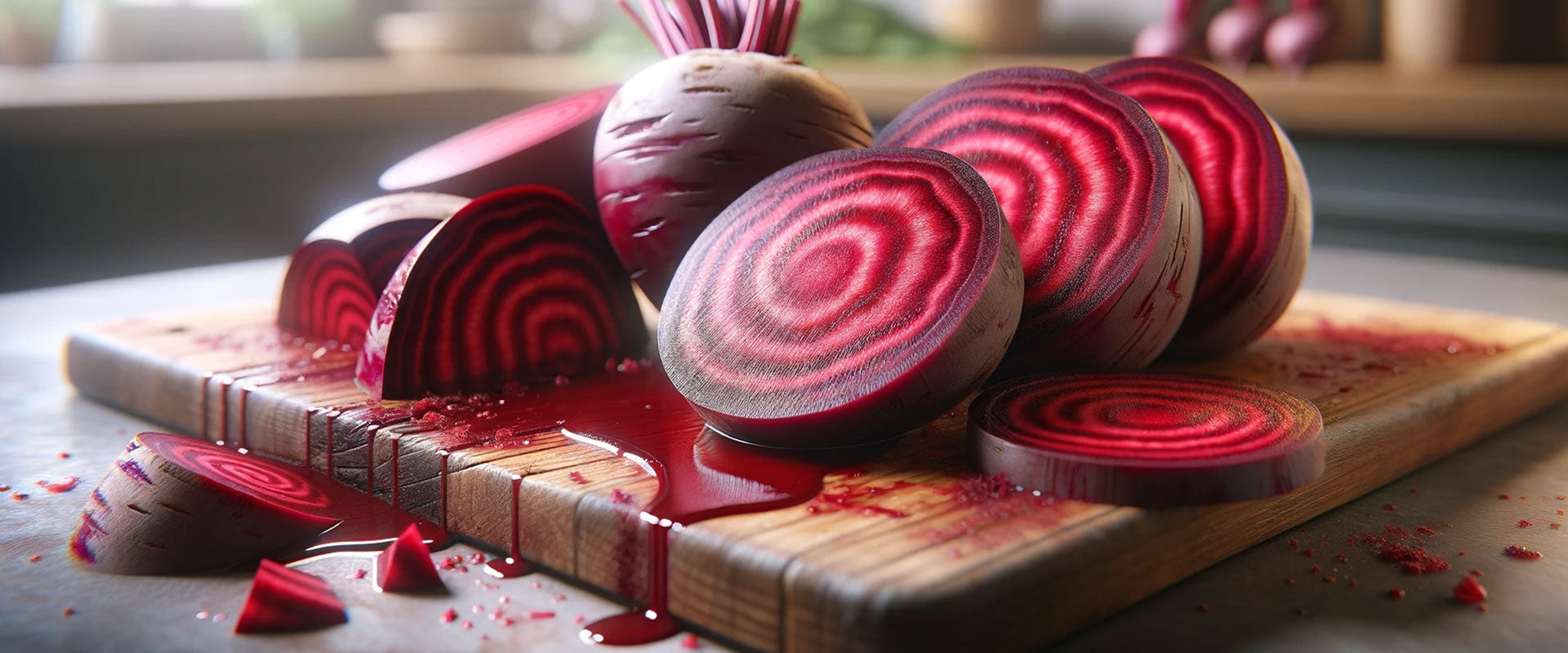Natural Red Food Coloring and Dye Recipe
The Beetroot Source
Beetroot is an incredibly versatile vegetable that has found its place as a natural food dye, owing to its rich, deep-red pigmentation. The pigmentation is largely due to the presence of betalains, organic compounds known for their antioxidant properties. To extract this dye, the beetroot is typically boiled in water, and the resulting liquid is used as a dye in various food products.

Recipe: Organic Red Food Coloring from Beets
Ingredients:
- 1 Cup of Organic Beets.
- 1 Cup (8 fl oz, 200ml) USDA Certified Organic 200 Proof Food Grade Ethanol.
Equipment
- 32 oz Glass Mason Jar with Lid
- 16 oz Glass Mason Jar with Lid
- Fine Mesh Strainer
Steps:
- Wash, peel and chop the beets into 1/2 inch (1 cm) pieces.
- Combine beets with 200 proof alcohol. Cover tightly with a clean lid, aluminum foil, or plastic wrap and a rubber band.
- Shake initially to integrate the beets with the alcohol. Allow to sit overnight at room temperature. Shaking more often than once initially is optionally.
- Strain the beets the next day, or let them remain in the alcohol indefinitely, the color will continue to intensify into a bright red all-natural food coloring.
- Store your all-natural red food coloring in a tightly sealed glass jar or bottle, away from sunlight and sources of heat (the refrigerator or freezer is a good spot).
Notes: Natural red color is delicate and can change over time thanks to oxidation. Use your organic natural food coloring as soon as possible for maximum color transfer into your favorite recipes.
Other Ingredients for Making Natural Red Food Color
If fresh beets are not available to you, try these other ingredients capable of delivering a natural red food coloring or dye when soaked using the method described above in 200 proof food grade alcohol. Start with a 1 to 1 ratio of your ingredient to alcohol and adjust the recipe to achieve your desired level of natural red color.
Red Cabbage
Red cabbage is another source of natural red dye. The color comes from a group of chemicals known as anthocyanins. The pigmentation can vary from red to blue, depending on the pH level of the food it's added to. For red hues, it's used in acidic foods, while for bluish tones, it's used in more alkaline dishes.

Raspberries and Strawberries
Red raspberries and strawberries are perfect natural sources for a warm, red food dye. Their color comes from anthocyanins, much like red cabbage. However, the pigments found in these fruits lean more towards red, making them ideal for creating a red food dye. The color extraction process is similar to beetroot, involving boiling or crushing the fruits and straining the juice.

Cochineal (Bugs)
A surprisingly potent natural red dye comes from the cochineal insect, native to Latin America. Cochineal extract, also known as carmine, is derived from the dried bodies of female cochineal insects. Though not suitable for vegans or those with insect allergies, this source provides a bright, stable red color used in a variety of foods.

High-Proof Alcohol vs. Water for Red Color Extraction
-
Efficiency of Extraction:
- Alcohol: Alcohol is a more efficient solvent for extracting color from many sources (like fruits, vegetables, and spices) because it can dissolve both water-soluble and oil-soluble compounds. This means you can extract a wider range of pigments more effectively.
- Water: Water can only dissolve water-soluble compounds, which may limit the range of colors you can extract.
-
Intensity and Stability of Color:
- Alcohol: The red colors extracted with alcohol tend to be more concentrated and vibrant. Alcohol’s lower boiling point means it evaporates quickly, leaving behind the pure pigment without dilution.
- Water: Water-based extracts might be less intense and can introduce additional water into your recipes, potentially affecting the texture and consistency of the final product.
-
Preservation and Shelf Life:
- Alcohol: Alcohol has natural preservative properties that can help extend the shelf life of your homemade red food coloring by inhibiting the growth of bacteria and mold.
- Water: Water-based extracts may spoil faster and usually require refrigeration. They are more prone to bacterial and mold growth.
-
Application Considerations:
- For baking and dry mixtures, alcohol-based extracts can be preferable because the alcohol evaporates during the baking process, leaving the color without additional moisture.
- For cold applications like icing, cocktails, or uncooked foods, both alcohol and water-based extracts can be used, but alcohol-based colors may offer more vibrant hues.




